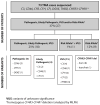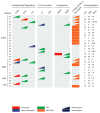Routine use of clinical exome-based next-generation sequencing for evaluation of patients with thrombotic microangiopathies
- PMID: 28752844
- PMCID: PMC5716882
- DOI: 10.1038/modpathol.2017.90
Routine use of clinical exome-based next-generation sequencing for evaluation of patients with thrombotic microangiopathies
Abstract
Next-generation sequencing is increasingly used for clinical evaluation of patients presenting with thrombotic microangiopathies because it allows for simultaneous interrogation of multiple complement and coagulation pathway genes known to be associated with disease. However, the diagnostic yield is undefined in routine clinical practice. Historic studies relied on case-control cohorts, did not apply current guidelines for variant pathogenicity assessment, and used targeted gene enrichment combined with next-generation sequencing. A clinically enhanced exome, targeting ~54 Mb, was sequenced for 73 patients. Variant analysis and interpretation were performed on genes with biological relevance in thrombotic microangiopathy (C3,CD46, CFB, CFH, CFI, DGKE, and THBD). CFHR3-CFHR1 deletion status was also assessed using multiplex ligation-dependent probe amplification. Variants were classified using American College of Medical Genetics and Genomics guidelines. We identified 5 unique novel and 14 unique rare variants in 25% (18/73) of patients, including a total of 5 pathogenic, 4 likely pathogenic, and 15 variants of uncertain clinical significance. Nine patients had homozygous deletions in CFHR3-CFHR1. The diagnostic yield, defined as the presence of a pathogenic variant, likely pathogenic variant or homozygous deletion of CFHR3-CFHR1, was 25% for all patients tested. Variants of uncertain clinical significance were identified in 21% (15/73) of patients.These results illustrate the expected diagnositic yield in the setting of thrombotic microangiopathies through the application of standardized variant interpretation, and highlight the utility of such an approach. Sequencing a clinically enhanced exome to enable targeted, disease-specific variant analysis is a viable approach. The moderate rate of variants of uncertain clinical significance highlights the paucity of data surrounding the variants in our cohort and illustrates the need for expanded variant curation resources to aid in thrombotic microangiopathy-related disease variant classification.
Figures


Similar articles
-
[Clinical characteristics and genetic profile of complement system in renal thrombotic microangiopathy in patients with severe forms of arterial hypertension].Ter Arkh. 2024 Jul 7;96(6):571-579. doi: 10.26442/00403660.2024.06.202724. Ter Arkh. 2024. PMID: 39106497 Russian.
-
High-Throughput Genetic Testing for Thrombotic Microangiopathies and C3 Glomerulopathies.J Am Soc Nephrol. 2016 Apr;27(4):1245-53. doi: 10.1681/ASN.2015040385. Epub 2015 Aug 17. J Am Soc Nephrol. 2016. PMID: 26283675 Free PMC article.
-
Copy number variation analysis using next-generation sequencing identifies the CFHR3/CFHR1 deletion in atypical hemolytic uremic syndrome: a case report.Hematology. 2022 Dec;27(1):603-608. doi: 10.1080/16078454.2022.2075121. Hematology. 2022. PMID: 35617302
-
Defining the genetics of thrombotic microangiopathies.Transfus Apher Sci. 2016 Apr;54(2):212-9. doi: 10.1016/j.transci.2016.04.011. Epub 2016 May 2. Transfus Apher Sci. 2016. PMID: 27177491 Review.
-
Shiga Toxin as a Potential Trigger of CFHR1 Deletion-Associated Thrombotic Microangiopathy.Am J Med Sci. 2018 Nov;356(5):492-498. doi: 10.1016/j.amjms.2018.05.012. Epub 2018 Jun 5. Am J Med Sci. 2018. PMID: 30177262 Review.
Cited by
-
Targeting complement dysregulation: eculizumab in scleroderma renal crisis management-a case-based review.Rheumatol Int. 2024 Dec;44(12):3135-3140. doi: 10.1007/s00296-024-05689-z. Epub 2024 Aug 15. Rheumatol Int. 2024. PMID: 39147912 Review.
-
Clinicopathologic Implications of Complement Genetic Variants in Kidney Transplantation.Front Med (Lausanne). 2021 Nov 29;8:775280. doi: 10.3389/fmed.2021.775280. eCollection 2021. Front Med (Lausanne). 2021. PMID: 34912830 Free PMC article.
-
Palmoplantar Keratoderma: A Molecular Genetic Analysis of Family Cases.Int J Mol Sci. 2022 Aug 24;23(17):9576. doi: 10.3390/ijms23179576. Int J Mol Sci. 2022. PMID: 36076978 Free PMC article.
-
Beyond Panel-Based Testing: Exome Analysis Increases Sensitivity for Diagnosis of Genetic Kidney Disease.Kidney360. 2020 May 13;1(8):772-780. doi: 10.34067/KID.0001342020. eCollection 2020 Aug 27. Kidney360. 2020. PMID: 35372954 Free PMC article.
References
-
- Nester CM, Barbour T, de Cordoba SR, et al. Atypical aHUS: State of the art. Mol Immunol. 2015;67:31–42. - PubMed
-
- George JN, Nester CM. Syndromes of thrombotic microangiopathy. N Engl J Med. 2014;371:654–666. - PubMed
-
- Noris M, Remuzzi G. Atypical hemolytic-uremic syndrome. N Engl J Med. 2009;361:1676–1687. - PubMed
Publication types
MeSH terms
Grants and funding
LinkOut - more resources
Full Text Sources
Other Literature Sources
Miscellaneous

